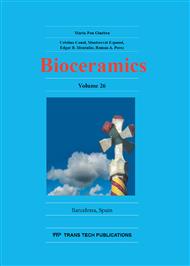p.402
p.408
p.414
p.420
p.426
p.430
p.435
p.443
p.448
Radiographic Changes Observed in THA Cemented Sockets Using Bone Cement and Hydroxyapatite Granules
Abstract:
The middle-term clinical and radiographic results were investigated in total hip arthroplasty (THA) cases using bone cement and hydroxyapatite (HA) granules (the interfacial bioactive bone cement technique; IBBC). 42 hip joins (39 cases) were operated between October 2005 and July 2007, and followed. The minimum follow-up was 6 years, average follow-up period was 7.0 years and average age at operation was 67 years. One revision was performed due to late infection. Average Japanese orthopaedic association (JOA) score improved from 48 to 87. Socket loosening was not observed radiographically. X-p findings of sockets demonstrated radiolucent line in the outer part of Zone 1 in 12% immediately after the operation, 24% at 2 years postoperatively. After 2 years there was no progressive change, however, improvement of radiolucent line (gap filling) with bone remodeling was observed in three cases after 3 years postoperatively.
Info:
Periodical:
Pages:
443-447
Citation:
Online since:
November 2014
Authors:
Price:
Сopyright:
© 2015 Trans Tech Publications Ltd. All Rights Reserved
Share:
Citation:


